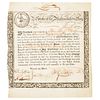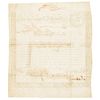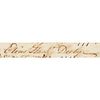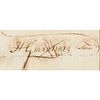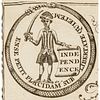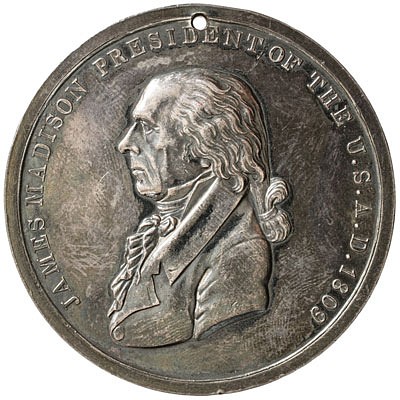Elias Hasket Derbys MA. Treasury Loan to Support the American Revolutionary War
Lot 187
Categories
Estimate:
$2,400 - $2,800
Absentee vs Live bid
Two ways to bid:
- Leave a max absentee bid and the platform will bid on your behalf up to your maximum bid during the live auction.
- Bid live during the auction and your bids will be submitted real-time to the auctioneer.
Bid Increments
| Price | Bid Increment |
|---|---|
| $0 | $10 |
| $200 | $20 |
| $300 | $25 |
| $500 | $50 |
| $1,000 | $100 |
| $2,000 | $200 |
| $3,000 | $250 |
| $5,000 | $500 |
| $10,000 | $1,000 |
| $20,000 | $2,000 |
| $30,000 | $2,500 |
| $50,000 | $5,000 |
| $100,000 | $10,000 |
| $200,000 | $20,000 |
| $300,000 | $25,000 |
| $500,000 | $50,000 |
About Auction
By Early American History Auctions
Jul 24, 2021
Set Reminder
2021-07-24 12:00:00
2021-07-24 12:00:00
America/New_York
Bidsquare
Bidsquare : A Revolutionary Numismatic Auction
https://www.bidsquare.com/auctions/early-american-history-auctions/a-revolutionary-numismatic-auction-7186
A Revolutionary Numismatic Auction Early American History Auctions auctions@earlyamerican.com
A Revolutionary Numismatic Auction Early American History Auctions auctions@earlyamerican.com
- Lot Description
American Revolution
Elias Hasket Derby's "State of the Massachusetts Bay" Loan to Support the American Revolutionary War 185 at 6% Annual Interest for 3 Years the Richest Man of the War Era, Owner of the Ship "Grand Turk" First U.S. Trade with China
June 1, 1777-Dated Revolutionary War Period, Partly-Printed Document, "State of Massachusetts Bay" Treasury Loan Certificate. Made Payable to Elias Hasket Derby. Bearing Six Percent Annual Interest. 3-Years. Anderson MA-7, with "Sword in Hand" vignette design after Paul Revere's Engraving, Choice Very Fine.
Listed by Anderson as Rarity-5 (31 to 75 known) for design type. Unique being issued to Patriot Elias Hasket Derby (1739-1799) the wealthy Salem, Mass. shipping merchant and businessman, being perhaps the most wealthy Patriots in the American Colonies. Authentic original 1777 Revolutionary War Bond stated: "Borrowed and received of Elias Hasket Derby..." measures 8.75" x 7.5" is boldly printed in black on fine-quality laid period paper with wide large full margins at left Indent, right side, top and bottom. Low Issued Serial Number "63". Completed in manuscript with dark-brown ink writing, in part: "Borrowed and received of Elias Hasket Derby the Sum of One hundred & Eighty Five Pounds for the Use and Service of the State of Massachussetts-Bay and in Behalf of said State I do hereby promise and oblige myself and successors in the office of Treasurer, to repay the Possessor by the First Day of June 1780, the aforesaid Sum of One hundred & Eighty Five Pounds Lawful Money, in Spanish Milled Dollars at Six Shillings each...".
This Bond type is listed in the Anderson reference book titled, "The Price of Liberty" as MA-7. This June 1, 1777 Loan Certificate was payable in June 1, 1780. The printed form has intricate engraving surrounding the text. What brings this bond its extreme collector popularity is Nathaniel Hurd's interpretation after Paul Revere's Engraving (seen on 1775 and 1776 Massachusetts Currency "Sword in Hand" issue notes) of a Colonial Minuteman / soldier holding high his Sword in his right hand with a scroll reading: "INDEPENDENCE" held in his left hand. All is surrounded by a Latin motto, which in turn is surrounded by a rattlesnake eating its own tail. This is low Serial number 63 of only 500 originally authorized printed. This example is clean and well presented on its printed face, yet has several minor internal fold and edge splits which have been reinforced on the blank reverse with clear fiber mesh tape. It's Signed four times. Three by members of the Treasury "Committee": D. Jeffries, C. Davis and D. Sumner, and also by H.(enry) Gardner, Treasurer, with a faint manuscript cancel on Gardner's signature. An exceptionally bold, sharp example with nice eye appeal of this historic issued "State of the Massachusetts Bay" Loan to Support the American Revolutionary War and owner of the Grand Turk, first American Ship to trade with China, by Elias Hasket Derby.
Elias Hasket Derby (1739-1799) / The House of Derby. Elias Hasket Derby's father, Richard Derby, had been one of the most prosperous merchants in Salem, Massachusetts.
In 1761 Elias Derby married Elizabeth Crownin-shield, daughter of another leading merchant family. After Derby took over managing his father's firm in the early 1780s, he made it one of the most successful businesses in America.
During the American Revolution the Derbys had made their commercial vessels into Privateers, raiding British commerce under the authority of the U.S. Congress. After the Revolution, having made a significant fortune during the Revolutionary War, Derby began sending his ships on longer voyages to South Africa, the Indian Ocean, and ultimately China and the Dutch East Indies.
The Ship "Grand Turk": Grand Turk (1780 ship), a 300-ton U.S. Privateer during the American Revolutionary War, built in 1780 for Elias Hasket Derby and owned by the Derby mercantile house, and was the First U.S. Ship on the China Trade.
Derby supervised every aspect of his business, from the building of ships to the direction of the voyages. But he recognized the limits of his own authority and so sought out trustworthy and resourceful men as captains and supercargo, or supervisor of the ship's cargo. He differed from many of his fellow merchants, who insisted on strict adherence to schedules and plans: "Obey orders if you break owners" was a maxim in the merchant marine.
But Derby trusted his agents, who would share in the profits of a successful voyage and thus grow wealthy along with him. For instance, in December 1785 Derby sent the Grand Turk, under Capt. Ebenezer West and William Vans, to the Cape of Good Hope. The Grand Turk carried a variety of goods: 35 hogsheads of tobacco, 20 casks of wine, 483 iron bars, 75 barrels of flour, 30 casks of rum, 42 casks of brandy, and 50 cases of oil, along with barrels of beef, rice, butter, cheese, fish, beer, candles, soap, prunes, and chocolate.
Derby's plan was for the ship to trade in South Africa and at the le de France, now the island of Mauritius, a leading market for coffee and sugar.
After two stormy months at sea the Grand Turk reached South Africa, where she sold some cargo and took on some more to sell further in the voyage. In March the ship reached the le de France; however, Vans and West found the prices of coffee and sugar too high. The voyage would not be profitable. But a French merchant asked to charter part of the ship's space to take a cargo to Canton, and in July the Grand Turk sailed for China.
In China the Americans traded their cargo for tea, hides, and porcelain, returning to Salem in May 1787 with a cargo valued at $23,000. Vans had bought the tea for about $53 per chest and sold it in New York for $120 per chest (in today's currency, about $1,500 each). On the whole, the voyage made a substantial profit. Derby had sent Vans and West to the le de France but expected that when the opportunity arose to trade with China, they would seize it.
Of note: The "Vintage Ship Grand Turk Salem 1786" is the symbol used for the brand "Old Spice" Shaving Mugs and other items as its Company Logo and masthead.
- Shipping Info
-
Early American provides in-house worldwide shipping. Please contact us directly if you have questions about your specific shipping requirements.
-
- Buyer's Premium



 EUR
EUR CAD
CAD AUD
AUD GBP
GBP MXN
MXN HKD
HKD CNY
CNY MYR
MYR SEK
SEK SGD
SGD CHF
CHF THB
THB
